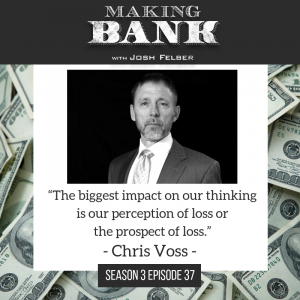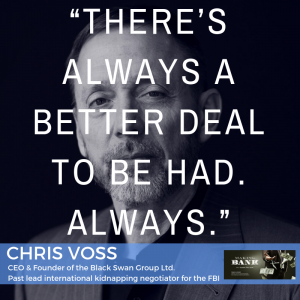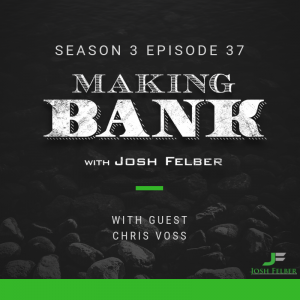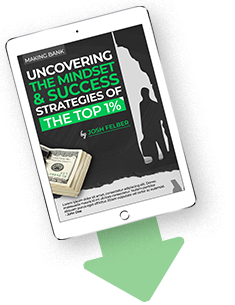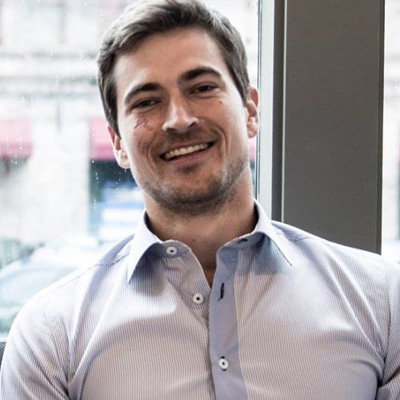Learn to Make Deals from an FBI Hostage Negotiator
with Chris Voss
Video:
Audio:
As a 24-year veteran in FBI hostage negotiation, it’s no surprise Chris Voss picked up incredible techniques to uncover people’s motivating forces and get to the bottom of who they are and what they want. What’s amazing is the way he facilitates business negotiations using the same tactics, and how we can start doing the same.
As a hostage negotiator, Chris’s job was to discover people’s perception and how he could change it. He learned to look for the loss in the past 24–48 hours that triggered the response that landed them in a hostage situation. In 2002 Daniel Kahneman won the Nobel Prize for his work on Prospect Theory asserting that all human behavior is motivated more by loss than anything else. When you’re looking to get under why people do what when — loss is the shortest road to your answer.
How does knowing this help your business negotiations? Whether you’re struggling to close a contract, vetting potential employees, or looking to expand into a new market with new people, discovering their most active motivators helps you know what kind of people they are, how/if they will fit into the landscape of your work, and what possible negative pitfalls they could fall into, So how do you discover the loss or motivating force?
Ask Initial Questions to Figure Out What is Important and Why
Mine discovery with small innocent observations. Voss said, “I’m trying to bypass your defense mechanisms, your primary prefrontal cortex, or the CEO of the brain — the traffic cop. I’m gonna get past it and get right into your emotional reaction.”
You can trigger response to get to the “floodgates of truth-telling” by engaging with designed questions. Remember Voss’s two examples:
“What about this is important to you?” vs “It sounds like this is important to you?”
It’s about how the words are designed, not their inflection. The second question yields a more honest answer because it puts the person in contemplation mode. They’re more likely to make a discovery, they themselves might not have been aware of, in your presence.
Look for the driving forces. It’s about discovering people’s core values and checking them against yours to see whether or not they line up — vetting for long term business partners. If you get people talking about something personal, it will tell you what kind of deals they are willing to make and what they will follow through on.
Discover the Deal
“There is always a better deal to be had, the hard part is figuring out, ‘Can I trust you to implement it?’” Once you listen to the tiny answers, the underpinnings that people unintentionally reveal, you can then discover if there is a deal to be made at all.
There might be red flags, but that doesn’t necessarily mean the deal has to be off. Have hard conversations and based on that communication you know what to watch out for, so when you go into the deal, you know where to look for the potential pitfalls of engagement with this person/company.
Close the Deal
“Give negotiation a chance. Negotiation is not a horrible thing if you give it a chance!”
Let the other side speak first. Have the courage to hear them out.
Paraphrase what the other side has said before you respond — don’t agree/disagree, just paraphrase. Seek to understand them first, then make yourself understood.
Be kind. You don’t need to hide what you want to say, but be nice and see what happens. It’s not about changing who you are, but softening the edges so other people can hear what you have to say. This saves you time and gets you off the “gerbil wheel of communication!”
Don’t split the difference in the deal! Recognize when people have better ideas than you and be willing to implement them. Compromise is damaging, blending ideas weakens them and makes them half-baked.
To learn more from Chris Voss subscribe to his newsletter by texting “FBIempathy” to 22828. You’ll receive a newsletter once a week on Tuesday mornings. You can find his book Never Split the Difference on Amazon.
Topics
- Accelerated Learning
- Artificial Intelligence
- Become Present
- Blockchain
- Branding
- Business
- Education
- Entrepreneurship
- Family
- Finance
- Health
- Health & Wellness
- Internet Marketing
- Investing
- Leadership
- Lifecoach
- Marketing
- Negotiation
- Performance
- Productivity
- Publicity
- Real Estate
- Sales
- Sales Success Habits
- Video Marketing
- Writing




